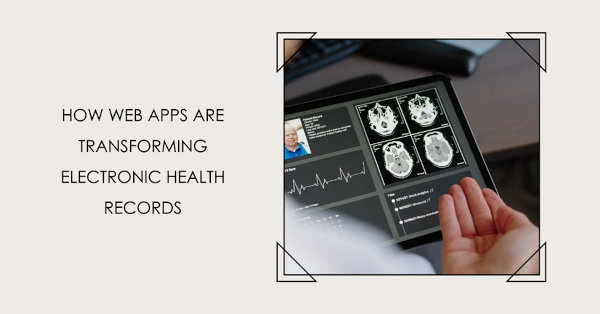In today’s digital era, every industry is taking a step towards digitization, and the healthcare industry is no exception. As you navigate your own healthcare experience, you may have noticed one significant shift in recent years—the transition from paper to digital records. Yes, we are talking about Electronic Health Records (EHRs), a remarkable advancement in the healthcare industry.

Web applications and websites are both important components of the digital transformation in healthcare. If you are not sure about selecting between web application or website development, you can refer to the blog on website vs web app.
While websites primarily serve as informational platforms, web applications offer a more interactive and dynamic experience, allowing users to perform specific tasks and store data.
When it comes to EHRs, web applications play a vital role in revolutionizing their management and accessibility. Let’s dig deeper into this topic and understand how web apps are transforming the concept of EHRs, while also highlighting the distinction between web apps and websites.
Understanding Electronic Health Records (EHRs)
Before we explore the impact of web apps, it’s crucial to have a clear understanding of EHRs.
- EHRs are digital versions of the traditional paper charts of a patient.
- They contain the patient’s medical history, diagnoses, medications, treatment plans, immunization dates, allergies, radiology images, and laboratory and test results.
- EHRs can be created, managed, and consulted by authorized providers and staff across healthcare organizations.
The question now is, how have web applications entered this domain? And how are they contributing to EHRs?
Role of Web Applications in EHRs
Web applications, or web apps, have come a long way since the 1990s when they primarily displayed static information. Now, these dynamic and interactive applications can perform tasks ranging from simple content delivery to complex financial transactions. You can get all the detailed information from the dashboard of EHRs. If you want to know the features to include in a dashboard, you can get the information from this blog – 5 features to include in a dashboard application.
Let’s understand now, how web apps are now reshaping EHRs in multiple ways:
Accessibility
The fundamental principle of web applications is that they can be accessed via the internet using a web browser. This aspect brings unprecedented levels of accessibility to Electronic Health Records (EHRs).
With web apps, healthcare professionals can access a patient’s records at any time, from any location, on any device with an internet connection—whether it’s a computer at the hospital, a tablet in a clinic, or even a smartphone at home. This universal accessibility not only streamlines healthcare processes but also enhances patient care, as clinicians have immediate access to the information they need to make informed decisions.
Integration
Web applications offer robust APIs (Application Programming Interfaces), which are sets of rules that allow different software applications to communicate with each other.
In the context of EHRs, this means that web apps can facilitate the integration of various healthcare systems—like scheduling, billing, or clinical decision support systems—directly into the EHR platform. For instance, a physician can schedule appointments, generate billing information, and leverage clinical decision support tools, all without leaving the EHR system. This seamless integration promotes efficiency and eliminates the need for multiple disparate systems.
Interoperability
This is a step beyond integration. Interoperability refers to the ability of different EHR systems to not only communicate and exchange data but also interpret and use the exchanged data. In essence, interoperability ensures that EHRs are not isolated systems but part of a broader healthcare network.
By promoting interoperability, web apps allow healthcare professionals to share patient information across different platforms, healthcare institutions, and even geographical borders. This information sharing leads to comprehensive patient care and eliminates duplication of tests or treatments.
Real-time updates
In a dynamic field like healthcare, information changes frequently. A change in a patient’s condition, a new diagnosis, or a recent test result—all of these need to be updated promptly in the patient’s record.
Web applications excel at providing real-time updates. As soon as a change is made in a patient’s EHR, it’s updated instantaneously across the system. This ensures that all healthcare professionals involved in the patient’s care have access to the most current information, which is critical for delivering timely and effective care.
Security
With the rise of cyber threats, securing sensitive information, like health records, has become a top priority. Web applications can employ robust security measures to protect EHRs. These include data encryption, which converts readable data into coded data that can only be read with a key; user authentication, which verifies the user’s identity before granting access to the EHR system; and regular data backups, which ensure that data can be recovered in the event of a loss.
Furthermore, web apps can enforce access controls, which limit access to patient records to only those who have the necessary authorization according to the research paper by Research Gate by Kabene, Leduc, and Gibson from The University of Western Ontario, ensuring the protection of personal health information is of utmost importance in EHR systems (Kabene et al., 2010).

The Transformational Effect of Web Apps on EHRs
Web apps are causing a significant shift in how EHRs are managed and used. Here are a few ways how this is happening:
Patient Engagement
Through web apps, patients can easily access their health records, enhancing patient engagement. They can review their records, ask relevant questions, and take an active part in managing their health.
Collaborative Care
Web apps allow for a collaborative approach to healthcare. With shared access to EHRs, healthcare teams can work together effectively, leading to improved patient outcomes.
Increased Efficiency
The ability to access and update EHRs in real-time, coupled with integration capabilities, significantly increases efficiency within healthcare systems.
Data-Driven Decisions
EHRs provided through web apps allow for the collection of extensive data. This data can be used for research, analytics, and helping healthcare professionals make more informed decisions.
Reduced Errors
The digitization of health records through web apps reduces the chances of errors that can occur with manual record-keeping, improving the overall quality of care.
As you can see, web apps are playing a fundamental role in transforming EHRs. They’re making healthcare more accessible, efficient, and patient-centered, all while ensuring security and privacy.
Future of EHRs and Web Apps
As technology continues to evolve, web apps will only become more influential in shaping the EHR landscape. Areas for future exploration include artificial intelligence (AI) and machine learning algorithms to predict patient outcomes, telemedicine for remote patient monitoring, and blockchain for enhanced security and data integrity.
EHRs powered by web apps are the future of healthcare. As a patient, understanding this transformation allows you to engage proactively in your healthcare journey. And as a healthcare provider, staying abreast of these trends can help you leverage technology to improve patient outcomes.
Remember, health is wealth. And with the transformation of EHRs through web apps, managing this wealth becomes much easier and more efficient. So, embrace this digital revolution as it unfolds, and witness how technology continues to enhance the healthcare industry.
In this digital age, staying updated with trends like these can help you stay one step ahead, whether you’re a patient, a healthcare provider, or a technology enthusiast. Technology continues to break boundaries, and in the case of web apps and EHRs, it’s doing so for the better.


